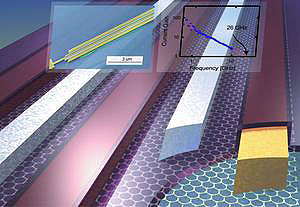YORKTOWN HEIGHTS, N.Y., Dec. 23, 2008 – IBM scientists from the company's T.J. Waston Research Center have demonstrated the operation of graphene field-effect transistors at gigahertz (GHz) frequencies.
Graphene, a special form of graphite, consists of a single layer of carbon atoms packed in honeycomb lattice, similar to an atomic-scale chicken wire. With a top gate design and a gate length of 150 nm, the team has achieved a cutoff frequency of 26 GHz for graphene transistors, the highest reported so far using this nonsilicon electronic material.
Graphene has attracted worldwide attention and activities because its unusual electronic properties eventually could lead to vastly faster transistors. 
Image courtesy of IBM's T.J. Watson Research Center.
This accomplishment is a milestone for the Carbon Electronics for RF Applications (CERA) program sponsored by DARPA, as part of the effort to develop the next generation of communication devices.
The work is performed by an interdisciplinary collaboration at the Watson Research Center. Integrating new materials along with the miniaturization of transistors is the driving force in improving the performance of next-generation electronic chips, according to researchers involved in the project.
The operation speed of a transistor is determined by the size of the device and the speed at which electrons travel. The size dependence was one of the driving forces to pursue ever-shrinking Si transistors in semiconductor industries. A key advantage of graphene lies in the very high electron speed with which electrons propagate in it, essential for achieving high-speed, high-performance transistors.
The scientists have fabricated nanoscale graphene field-effect transistors and demonstrated the operation of graphene transistors at the gigahertz frequency range. More importantly, the scaling behavior (the size dependence of the performance of the graphene transistors) was established for the first time. The team found that the operation frequency increases with diminishing device dimension and achieved a cutoff frequency of 26 GHz for graphene transistors with a gate length of 150 nm, the highest frequency ever obtained for graphene.
The researchers expect that, by improving the gate dielectric materials, the performance of these graphene transistors could be further enhanced. They believe that terahertz graphene transistors could be achieved in an optimized graphene transistor with a gate length of 50 nm. In the next phase, they plan to pursue RF (radio frequency) circuits based on these high-performance transistors.
For more information, visit: www.ibm.com